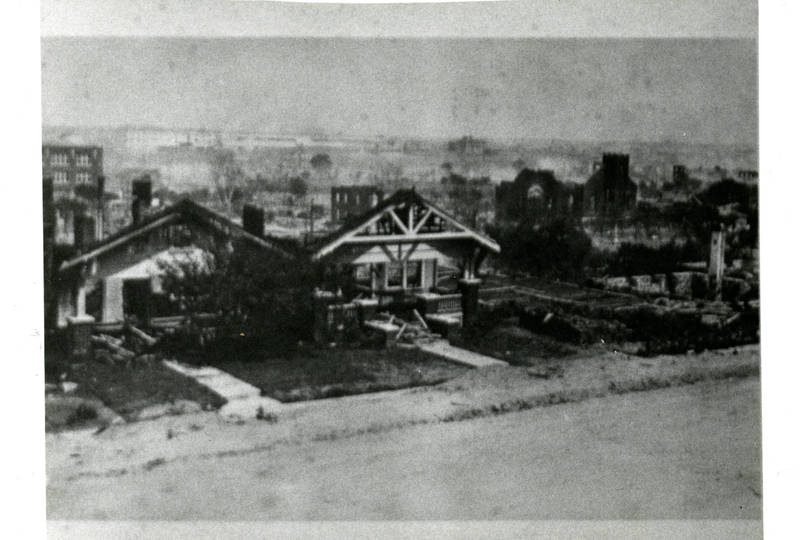Voices of the Massacre
May 31st, 1921. Greenwood was thriving. Black Wall Street. Dick Rowland. Sarah Page. An elevator. A white mob. The courthouse. 75 Black men. 1500 white men. Black men retreat. White mob follows. An entire district is burned down to the ground. 300 plus Black people die. Thousands of survivors are terrorized. The whole community is robbed of the fruitful future and generational wealth that was being built despite being in a place where white entitlement ran and continues to run rampant.
Too often, the narrative of what sparked the Tulsa Race Massacre overshadows the effects on the lives of the survivors of the event. The incomprehensible loss of family, friends, homes, and the future of generational wealth for the entire community. The terror that so many of these young survivors lived with for the rest of their days. And the lack of acknowledgment by the very city they dreamed of giving back to. Below is a glimpse into the memories of the individuals whose lives were dismantled and whose persepectives are just as important to the history of Tulsa as to the massacre itself.
Collected by the Greenwood Cultural Center
Pictures provided by the Ruth Sigler Avery Collection
"When the riot broke out, I was a teenager working as a bellhop at the Mills hotel in downtown Tulsa. We made good money. Tulsa was a booming oil town and people were always coming to Tulsa. Hotels, restaurants, entertainment places, taxis, shoe shine parlors, department stores, banks, churches (so many on Boulder Avenue that it was called Cathedral Row) - all profited in the booming oil town. And then came the riot!"
Clarence Bruner
"Mobsters had kicked a hole in the side of the store and had set it on fire. That was the saddest day of my life. That riot cheated us out of childhood innocence. My life dreams were destroyed too by that riot. In fact, I had made up my mind to become a school teacher when I grew up. But that riot put an end to that."
Beulah Lane Keenan Smith
"On June 1, 1921, when things got so bad, my grandparents sent me on with the neighbors, the Butlers. The Butlers hooked up two mules to a wagon and we headed for Mohawk Park to get away from the fast-approaching mobsters. My grandmother and my cousin were picked up by the guards and taken to the Red Cross. Men and boys were taken by the militia to the Convention Center."
Simon R. Richardson
"At the time of the Tulsa riot, my father, J.D. (Dick Bell) and my mother, Ida Mae Bell lived at 418 N. Cincinnati Avenue in Tulsa. My mother was eight months pregnant with me. Dad and mother came from Missouri to Tulsa in 1918 to get in on the oil boom successes there. Dad was a chauffeur for rich whites such as Tate Brady, Judge Shea, and the owner of Crosby Farms. When the riot started, mother and dad fled along the Santa Fe Railroad tracks, with other fleeing black refugees all the way to Mohawk Indian Nation Park."
James D. Bell
"I saw what I thought were little black birds dropping out of the sky over the Greenwood District. But those were no little birds; what was falling from the sky over the Negro district, as it was called in those days, were bullets and devices to set fires, and debris of all kinds. Mother, sensing the danger, ran out and got me and took me into the house. I saw a truckload of dead bodies being carried somewhere. I was just spellbound looking at those bodies - bodies that looked like they had just haphazardly been thrown onto that truck, with arms and legs just dangling. I got closer so I could see better and I noticed that the faces and arms were black but that when the arms dangled, a person could see white at the top of the arms. I asked about that. I learned later that those were white men who had painted their faces and arms black so they could get into the Greenwood community under false pretenses. But when they started shooting down the black people, their game was up and they, themselves, got shot down. Many other black riot victims told of white bosses who had cots, blankets, and food already in place at their homes and businesses just waiting for their black employees when the riot broke out. They had to know that the riot was coming."
Genevieve Elizabeth Tillman Jackson
"On June 1, 1921, we were found by the guards and taken to the fairgrounds. A white man who mother knew came and took us home. Going back to Greenwood was like entering a war zone. Everything was gone! People were moaning and weeping when they looked at where their homes and businesses once stood. I'll never forget it. No, not ever!"
Ernestine Gibbs
These stories speak to the depth in which the entire community was affected. Too often people focus on what actually sparked the massacre and speak of the broad destruction of the Greenwood District despite it being about the individuals just as much as it is about an entire community. It is important to remember that it is within the myriad individual experiences that the scope of the tragedy lies.
Please visit The Greenwood Cultural Center to learn how to make a reservation to access more stories from Tulsa Race Massacre survivors.
